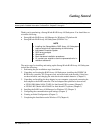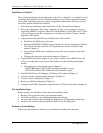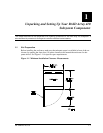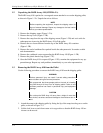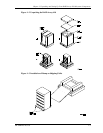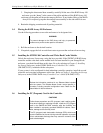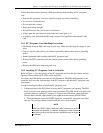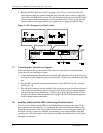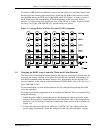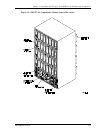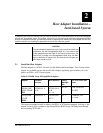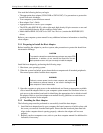
Chapter 1. Unpacking and Setting Up Your RAID Array 410 Subsystem Components
EK–SMRAC–IG. C01 1–5
Follow these electrostatic discharge (ESD) precautions when handling the PC (program)
card.
• Keep the PC (program) card in its original carrying case unless installing it.
• Do not twist or bend the card.
• Do not touch the contacts.
• Keep out of direct sunlight.
• DO NOT immerse the card in water or chemicals.
• Always push the eject button to remove the card (see Figure 1–4).
• A properly worn and attached ESD strap is required for installation and removal of the
card.
1.6.1 PC (Program) Card Handling Precautions
• Obtain and attach an ESD wrist strap to your wrist. Make sure the strap fits snugly on your
wrist.
• Plug (or clip) the other end to your cabinet's grounding stud (or other chassis grounding
point).
• Remain grounded while working with the PC (program) card.
• Remove the ESD connection from the cabinet ground stud or other chassis grounding
point.
• Remove the ESD wrist strap from your wrist.
1.6.2 Installing PC (Program) Card in Controller
Refer to Figure 1–4 for the location of the PC (program) card slot, the eject button, and the
Operator Control Panel (OCP) LEDs on the controller.
For clarity, the ESD shield is not shown in the illustration. The ESD shield attaches to the
controller and covers the exposed edge of the PC (program) card and the PC (program) card
eject button.
Use the following procedure to install the PC (program) card:
1. Unsnap and remove the ESD shield covering the PC (program) card opening. The ESD
shield covers the card opening and the card eject button. The ESD shield is secured to the
controller with two “push/pull” fasteners. To remove the ESD shield, gently pull both
fastener shafts outward, approximately one-eighth inch and remove the ESD shield.
2. While holding the controller RESET depressed, insert the PC (program) card (label
side up). The card eject button extends when the card is fully inserted.
NOTE
Keep the RESET button depressed while inserting the card to
minimize the possibility of transients damaging the card contents
and also to ensure that the controller reinitializes when the button
is released.



